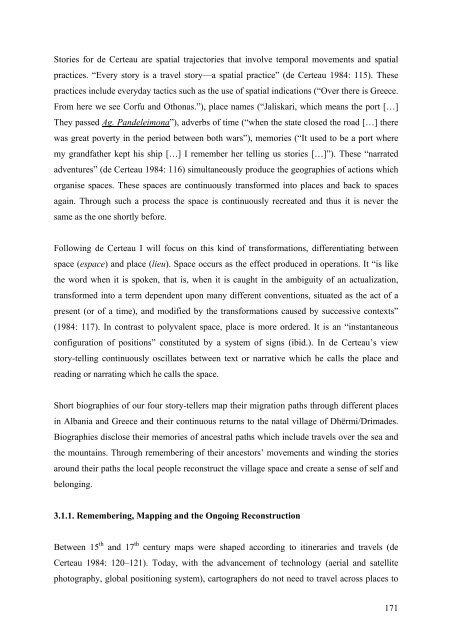university of nova gorica graduate school contested spaces and ...
university of nova gorica graduate school contested spaces and ...
university of nova gorica graduate school contested spaces and ...
Create successful ePaper yourself
Turn your PDF publications into a flip-book with our unique Google optimized e-Paper software.
Stories for de Certeau are spatial trajectories that involve temporal movements <strong>and</strong> spatial<br />
practices. “Every story is a travel story—a spatial practice” (de Certeau 1984: 115). These<br />
practices include everyday tactics such as the use <strong>of</strong> spatial indications (“Over there is Greece.<br />
From here we see Corfu <strong>and</strong> Othonas.”), place names (“Jaliskari, which means the port […]<br />
They passed Ag. P<strong>and</strong>eleimona”), adverbs <strong>of</strong> time (“when the state closed the road […] there<br />
was great poverty in the period between both wars”), memories (“It used to be a port where<br />
my gr<strong>and</strong>father kept his ship […] I remember her telling us stories […]”). These “narrated<br />
adventures” (de Certeau 1984: 116) simultaneously produce the geographies <strong>of</strong> actions which<br />
organise <strong>spaces</strong>. These <strong>spaces</strong> are continuously transformed into places <strong>and</strong> back to <strong>spaces</strong><br />
again. Through such a process the space is continuously recreated <strong>and</strong> thus it is never the<br />
same as the one shortly before.<br />
Following de Certeau I will focus on this kind <strong>of</strong> transformations, differentiating between<br />
space (espace) <strong>and</strong> place (lieu). Space occurs as the effect produced in operations. It “is like<br />
the word when it is spoken, that is, when it is caught in the ambiguity <strong>of</strong> an actualization,<br />
transformed into a term dependent upon many different conventions, situated as the act <strong>of</strong> a<br />
present (or <strong>of</strong> a time), <strong>and</strong> modified by the transformations caused by successive contexts”<br />
(1984: 117). In contrast to polyvalent space, place is more ordered. It is an “instantaneous<br />
configuration <strong>of</strong> positions” constituted by a system <strong>of</strong> signs (ibid.). In de Certeau’s view<br />
story-telling continuously oscillates between text or narrative which he calls the place <strong>and</strong><br />
reading or narrating which he calls the space.<br />
Short biographies <strong>of</strong> our four story-tellers map their migration paths through different places<br />
in Albania <strong>and</strong> Greece <strong>and</strong> their continuous returns to the natal village <strong>of</strong> Dhërmi/Drimades.<br />
Biographies disclose their memories <strong>of</strong> ancestral paths which include travels over the sea <strong>and</strong><br />
the mountains. Through remembering <strong>of</strong> their ancestors’ movements <strong>and</strong> winding the stories<br />
around their paths the local people reconstruct the village space <strong>and</strong> create a sense <strong>of</strong> self <strong>and</strong><br />
belonging.<br />
3.1.1. Remembering, Mapping <strong>and</strong> the Ongoing Reconstruction<br />
Between 15 th <strong>and</strong> 17 th century maps were shaped according to itineraries <strong>and</strong> travels (de<br />
Certeau 1984: 120–121). Today, with the advancement <strong>of</strong> technology (aerial <strong>and</strong> satellite<br />
photography, global positioning system), cartographers do not need to travel across places to<br />
171

















